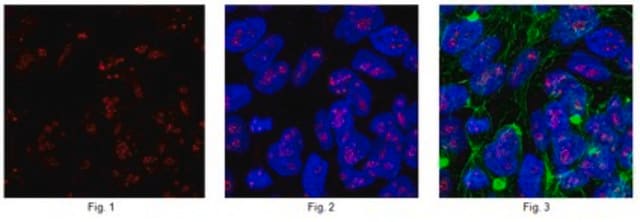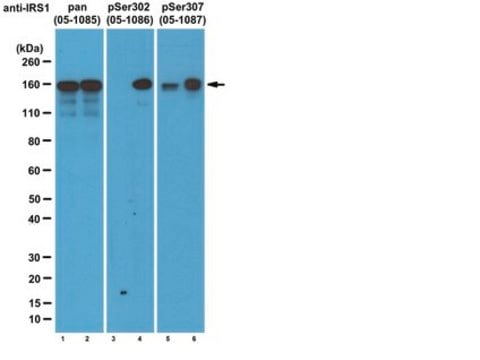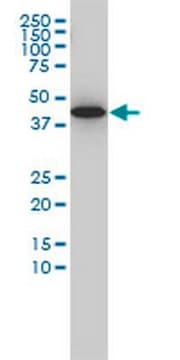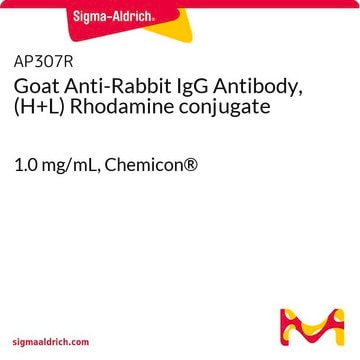ABN1727
Anti-CASZ1 Antibody
from guinea pig
Sinonimo/i:
Zinc finger protein castor homolog 1, Castor-related protein, CASZ1V1, CASZ1V2, Putative survival-related protein, Zinc finger protein 693
About This Item
Prodotti consigliati
Origine biologica
guinea pig
Livello qualitativo
Forma dell’anticorpo
unpurified
Tipo di anticorpo
primary antibodies
Clone
polyclonal
Reattività contro le specie
mouse, human
tecniche
immunocytochemistry: suitable
immunofluorescence: suitable
immunoprecipitation (IP): suitable
western blot: suitable
N° accesso NCBI
N° accesso UniProt
Condizioni di spedizione
ambient
modifica post-traduzionali bersaglio
unmodified
Informazioni sul gene
human ... CASZ1(54897)
mouse ... Casz1(69743)
Descrizione generale
Specificità
Immunogeno
Applicazioni
Immunofluorescence Analysis: A 1:1,000 dilution from a representative lot detected CASZ1 immunoreactivity only among EYFP-negative cells, but not EYFP-positive Casz1-knockout cells by fluorescent immunohistochemistry staining of 4% paraformaldehyde-fixed retina cryosections from E17.5 transgenic mouse embryos carrying floxed Casz1 alleles and a ROSA26-floxed-stop::EYFP reporter allele, as well as Pax6 promoter-driven cre recombinase expression to allow tissue-specific (conditional) Casz1 knockout (Courtesy of Pierre Mattar, Christine Jolicoeur, and Michel Cayouette, Institut de recherches cliniques de Montreal (IRCM), Canada).
Immunoprecipitation Analysis: 5 µL from a representative lot immunoprecipitatd CASZ1 from 1 mg of mouse retina extract (Courtesy of Pierre Mattar, Christine Jolicoeur, and Michel Cayouette, Institut de recherches cliniques de Montreal (IRCM), Canada).
Western Blotting Analysis: A 1:1,000 dilution from a representative lot detected both CASZ1 spliced variants (CASZ1V1 and CASZ1V2) of either human or mouse origin in 20 µg of lysates from respective HEK293T transfectants (Courtesy of Pierre Mattar, Christine Jolicoeur, and Michel Cayouette, Institut de recherches cliniques de Montreal (IRCM), Canada).
Western Blotting Analysis: A 1:500 dilution from a representative lot detected a CASZ1 immunoreactive band in E17.5 mouse embryonic retina extract, but not in lysate from untransfected HEK293 cells (Courtesy of Pierre Mattar, Christine Jolicoeur, and Michel Cayouette, Institut de recherches cliniques de Montreal (IRCM), Canada).
Neuroscience
Qualità
Western Blotting Analysis: A 1:5,000 dilution of this antiserum detected both CASZ1 spliced variants (CASZ1V1 and CASZ1V2) of either human or mouse origin in 10 µg of lysates from respective HEK293T transfectants.
Descrizione del bersaglio
Stato fisico
Stoccaggio e stabilità
Handling Recommendations: Upon receipt and prior to removing the cap, centrifuge the vial and gently mix the solution. Aliquot into microcentrifuge tubes and store at -20°C. Avoid repeated freeze/thaw cycles, which may damage IgG and affect product performance.
Altre note
Esclusione di responsabilità
Not finding the right product?
Try our Motore di ricerca dei prodotti.
Codice della classe di stoccaggio
12 - Non Combustible Liquids
Classe di pericolosità dell'acqua (WGK)
WGK 1
Punto d’infiammabilità (°F)
Not applicable
Punto d’infiammabilità (°C)
Not applicable
Certificati d'analisi (COA)
Cerca il Certificati d'analisi (COA) digitando il numero di lotto/batch corrispondente. I numeri di lotto o di batch sono stampati sull'etichetta dei prodotti dopo la parola ‘Lotto’ o ‘Batch’.
Possiedi già questo prodotto?
I documenti relativi ai prodotti acquistati recentemente sono disponibili nell’Archivio dei documenti.
Il team dei nostri ricercatori vanta grande esperienza in tutte le aree della ricerca quali Life Science, scienza dei materiali, sintesi chimica, cromatografia, discipline analitiche, ecc..
Contatta l'Assistenza Tecnica.








